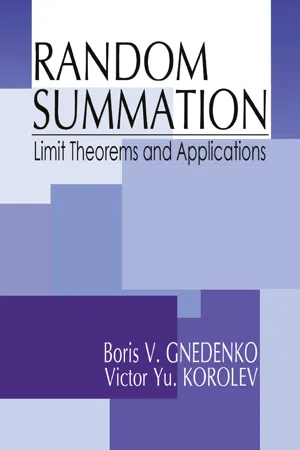
- 288 pages
- English
- ePUB (mobile friendly)
- Available on iOS & Android
About This Book
This book provides an introduction to the asymptotic theory of random summation, combining a strict exposition of the foundations of this theory and recent results. It also includes a description of its applications to solving practical problems in hardware and software reliability, insurance, finance, and more. The authors show how practice interacts with theory, and how new mathematical formulations of problems appear and develop.
Attention is mainly focused on transfer theorems, description of the classes of limit laws, and criteria for convergence of distributions of sums for a random number of random variables. Theoretical background is given for the choice of approximations for the distribution of stock prices or surplus processes. General mathematical theory of reliability growth of modified systems, including software, is presented. Special sections deal with doubling with repair, rarefaction of renewal processes, limit theorems for supercritical Galton-Watson processes, information properties of probability distributions, and asymptotic behavior of doubly stochastic Poisson processes.
Random Summation: Limit Theorems and Applications will be of use to specialists and students in probability theory, mathematical statistics, and stochastic processes, as well as to financial mathematicians, actuaries, and to engineers desiring to improve probability models for solving practical problems and for finding new approaches to the construction of mathematical models.
Frequently asked questions
Information
Chapter 1
Examples
1.1 Examples related to generalized Poisson laws
(1.1) |
(1.2) |
(1.3) |
(1.4) |
(1.5) |
Table of contents
- Cover
- Half Title
- Title Page
- Copyright Page
- Preface
- Table of Contents
- 1 Examples
- 2 Doubling with Repair
- 3 Limit Theorems for “Growing” Random Sums
- 4 Limit Theorems for Random Sums in the Double Array Scheme
- 5 Mathematical Theory of Reliability Growth. A Bayesian Approach
- Appendix 1. Information Properties of Probability Distributions
- Appendix 2. Asymptotic Behavior of Generalized Doubly Stochastic Poisson Processes
- Bibliographical Commentary
- References
- Index